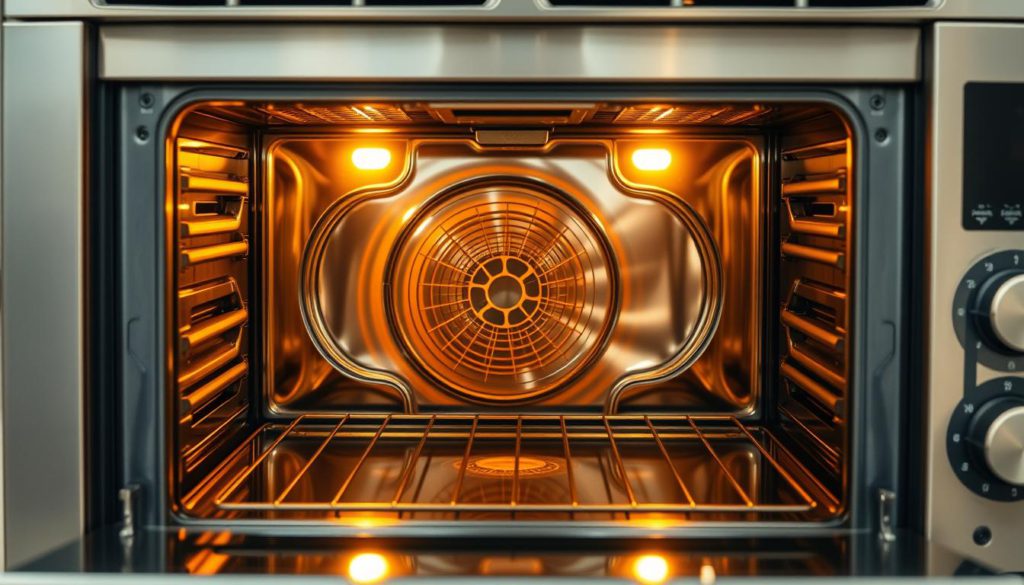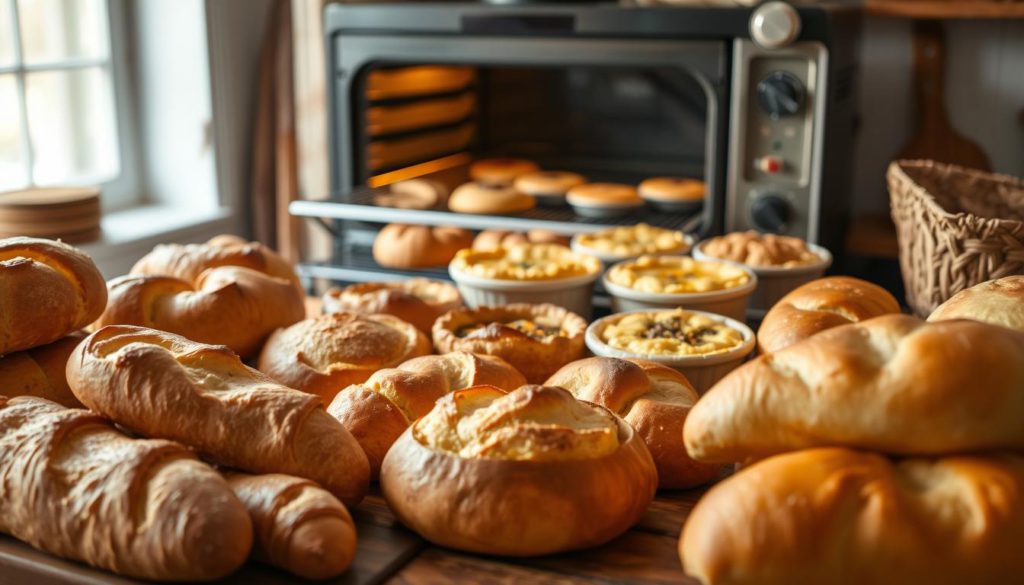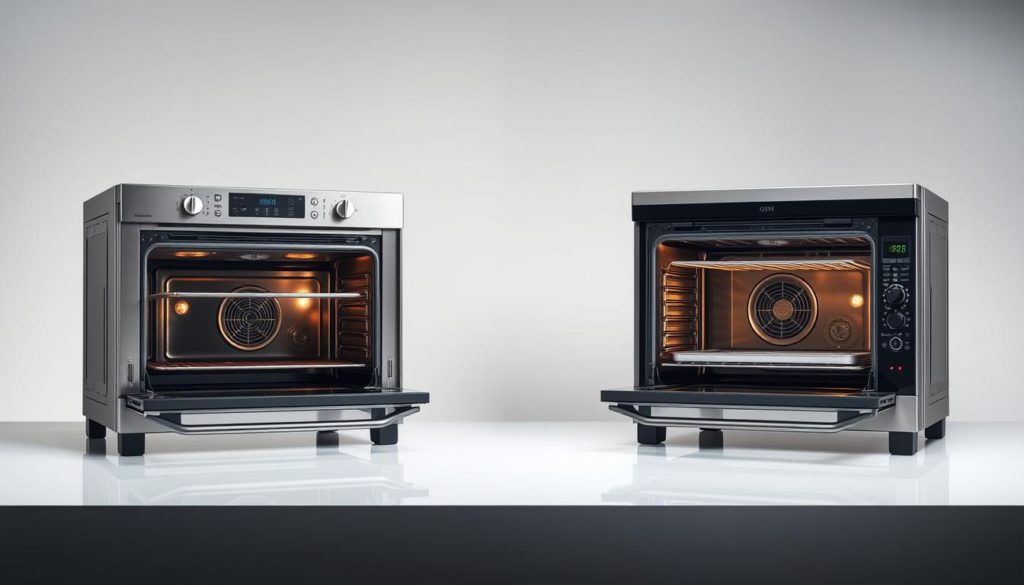Did you know your oven could be the secret to better meals—or your biggest kitchen frustration? The right appliance doesn’t just bake cookies or roast chicken; it shapes your entire culinary experience. But with two popular options available, which one truly fits your needs?
- Understanding the Key Differences Between Convection and Conventional Ovens
- Advantages of Convection Ovens for Modern Cooking
- Benefits of Conventional Ovens in Everyday Use
- How to Choose Between a Convection and Conventional Oven
- Adjusting Recipes and Oven Settings for Optimal Results
- Maintenance and Calibration Tips for Your Oven
- Conclusion
- FAQ
Convection ovens use a built-in fan and sometimes a third heating element to circulate hot air. This design cooks food faster and more evenly than traditional models. Conventional ovens rely on radiant heat from top and bottom elements, which works well for many dishes but can create uneven results.
Most recipes are designed for standard ovens without fans. If you’ve ever wondered why your baked goods brown too quickly or meats dry out, your oven type might be the culprit. Modern models now offer features like no-preheat modes or automatic temperature conversions, but understanding core differences remains key.
Your cooking style matters. Do you prioritize speed for weeknight dinners? Prefer crispy roasted vegetables or delicate pastries? We’ll explore how heat distribution, cooking times, and recipe tweaks can guide your decision—because great meals start with the right tools.
Key Takeaways
- Convection ovens circulate air for faster, more even cooking
- Standard recipes often require temperature adjustments for convection models
- Third heating elements in some models enhance browning
- Conventional ovens work better for dishes needing steady, gentle heat
- Modern features like no-preheat modes save time and energy
Understanding the Key Differences Between Convection and Conventional Ovens

The battle of kitchen appliances often boils down to how heat moves. Convection models use a fan and exhaust system to circulate hot air throughout the cavity. This design eliminates cold zones, letting you bake cookies on three racks simultaneously without rotating trays.
Fan-Powered Cooking Technology
Built-in fans push heated air around food surfaces, creating consistent temperatures from edge to edge. The exhaust system pulls moisture away, giving roasted vegetables crispier skins. This air circulation works best for multi-rack cooking and dishes needing even browning.
Traditional Heat Sources Explained
Standard models rely on top and bottom heating elements that radiate warmth upward. Without active airflow, temperature variations develop between oven shelves. You’ll often rotate casseroles halfway through cooking to prevent uneven results.
| Feature | Convection | Conventional |
|---|---|---|
| Heat Source | Fan + heating elements | Top/bottom elements |
| Air Movement | Active circulation | Natural rise |
| Cooking Speed | 25% faster | Standard time |
| Best For | Multi-rack baking | Delicate custards |
Understanding these mechanics helps match appliance strengths to your favorite recipes. While convection models excel at speed and uniformity, traditional ovens maintain gentler heat for sensitive dishes.
Advantages of Convection Ovens for Modern Cooking
Unlock faster, more even cooking results with the science behind convection technology. These appliances tackle common kitchen challenges through smart heat management, offering precision that transforms meal preparation.
Even Heat Distribution with Fan and Exhaust Systems
The secret lies in the fan exhaust system. It pushes hot air around food while pulling moisture away. This dual action eliminates cold spots, letting you bake three trays of cookies simultaneously without rotating pans.
Faster Cooking and Multi-Rack Efficiency
Meals cook faster—about 25% quicker than traditional methods. Circulated air transfers heat rapidly to all surfaces. You can use multiple racks efficiently for holiday feasts or weekly meal prep, saving time and energy.
| Feature | Benefit |
|---|---|
| True Convection | Enhanced browning with third heating element |
| Multi-Rack Capacity | Cook 2-3 dishes evenly at once |
| Speed Boost | Reduces roasting times by 15-20 minutes |
True Convection Benefits Including the Third Heating Element
High-end models with true convection add a third heating element behind the fan. This setup accelerates preheating and creates restaurant-quality crusts on breads and meats. It’s why professional chefs favor this technology.
From crispy roasted veggies to golden pastries, these ovens handle diverse tasks effortlessly. Their ability to manage multiple racks while maintaining consistency makes them ideal for modern households.
Benefits of Conventional Ovens in Everyday Use

Trusted by generations, conventional ovens deliver consistent results for everyday cooking. Their straightforward design matches most recipe requirements, eliminating guesswork. Home chefs appreciate predictable performance when preparing family favorites or holiday feasts.
Familiar Cooking Experience with Standard Settings
These appliances shine with recipes developed over decades. Cakes rise evenly, cookies spread properly, and casseroles bubble without drying out. You won’t need conversion charts or temperature adjustments—just follow instructions as written.
Delicate baked goods like soufflés or custards thrive here. Radiant heat from top and bottom elements provides gentle warmth. This prevents rapid moisture loss, keeping cheesecakes creamy and bread puddings tender.
Ideal for Certain Baking and Delicate Recipes
While you might need rotate dishes during cooking, this process ensures even browning. Roasts develop crisp exteriors while staying juicy inside. Casseroles achieve golden tops without burning edges.
| Advantage | Why It Matters |
|---|---|
| Consistent Heat | No sudden temperature shifts for reliable results |
| Recipe Compatibility | Works with 90% of existing baked goods instructions |
| Moisture Retention | Better for custards, quick breads, and braised meats |
| Manual Control | Adjust positioning if you need rotate dishes |
For traditional meals and comfort foods, conventional ovens remain unmatched. Their simplicity and proven track record make them essential for stress-free cooking.
How to Choose Between a Convection and Conventional Oven

What determines your kitchen success more than ingredients or skills? Your appliance choices. Start by evaluating what sizzles in your weekly meal rotation—are you baking single-layer cakes or roasting veggies on three racks?
Assessing Your Cooking Needs and Recipe Types
Frequent multi-dish cooks gain most from ovens convection models. The fan-driven heat lets you roast chicken while crisping potatoes on separate shelves. But if your recipes focus on custards or artisanal breads, radiant heat from standard models preserves delicate textures better.
Comparing Features and Price Points
Automatic temperature converters in premium wall ovens simplify recipes designed for traditional models. Entry-level units might lack this perk—you’ll manually adjust settings. Expect to spend 15-30% more for true convection systems with third heating elements.
Before purchasing, find store locations to test rack configurations. Use convection modes during demos to gauge noise levels. Savvy shoppers status find their online orders weekly to track delivery updates for smarter planning.
Match your must-haves: Families needing speed might prioritize fan-assisted models, while bakers often prefer conventional reliability. Either way, use convection capabilities as a bonus—not a requirement—if your meals don’t demand it.
Adjusting Recipes and Oven Settings for Optimal Results
Mastering your oven’s capabilities transforms good dishes into great ones. Since most recipes assume standard heat sources, convection models demand thoughtful tweaks. The fan’s air circulation alters cooking dynamics—knowing when to adapt ensures flawless results every time.
Temperature and Time Modifications for Convection Cooking
When using convection, start by lowering temperatures 25°F. Reduce cooking times by 25% to prevent overbrowning. The third heating element accelerates heat transfer, so check dishes 5-10 minutes earlier than usual.
Roasts and cookies benefit most from these adjustments. Circulated air penetrates surfaces faster, crisping skins while locking in juices. For multi-rack baking, maintain 2-3 inches between pans so hot air flows freely throughout oven cavities.
| Recipe Type | Convection Adjustment |
|---|---|
| Cookies | 325°F instead of 350°F |
| Chicken | 20 mins/lb vs 25 mins/lb |
| Casseroles | Cover first ⅔ cooking time |
When to Deselect Convection Mode for Better Results
Turn off the fan for delicate tasks like soufflés or custards. Radiant heat preserves moisture better than moving air. Cheesecakes develop smoother textures without convection’s drying effect.
Always consult your oven’s manual—some models auto-adjust settings when toggling modes. If baking results vary, track changes in a notebook. Consistent tweaks build intuition for using convection effectively across recipes.
Maintenance and Calibration Tips for Your Oven
Your oven’s performance hinges on more than just temperature settings—it thrives on consistent care. Regular upkeep ensures even cooking, energy efficiency, and extended appliance life. Let’s break down essential practices to keep your oven in top shape.
Cleaning, Calibration, and Regular Checks
Weekly wipe-downs prevent grease buildup that affects heat distribution. Use manufacturer-approved cleaners to avoid damaging sensors. For stuck-on spills, mix baking soda and water into a paste—scrub gently after 15 minutes.
Calibrate your oven annually. An oven thermometer reveals temperature discrepancies. If readings differ by 25°F or more, adjust settings using your model’s manual. Some units have built-in calibration modes for quick fixes.
- Rotate dishes halfway in conventional ovens for even browning
- Check door seals monthly—replace if cracked or loose
- Schedule professional inspections every 2-3 years
Conventional models often require rotating dishes during baking. This compensates for uneven heat distribution. For persistent issues, use your retailer’s status find store tool to locate service centers. Track repair progress through order status portals once booked.
| Task | Frequency | Impact |
|---|---|---|
| Interior cleaning | Monthly | Prevents smoke/flavor transfer |
| Thermometer test | Yearly | Ensures accurate temps |
| Vent inspection | 6 months | Maintains airflow |
Proper care directly affects how your foods turn out. Burnt crumbs or faulty sensors can alter cooking times. Keep manuals handy—many brands offer online access if you status find store resources. Addressing small issues early prevents costly repairs and keeps your favorite foods tasting their best.
Conclusion
Your perfect kitchen companion hinges on matching technology to your culinary ambitions. Convection ovens excel with their fan-driven heat circulation, reducing cook times while handling multiple racks effortlessly. The third heating element in premium models boosts browning precision—ideal for crispy roasts or golden pastries.
Traditional models remain unmatched for delicate dishes like custards or artisan breads. Radiant heat from top and bottom heating elements preserves moisture better than moving hot air. This makes them reliable for classic recipes requiring steady warmth.
Adjust settings when using convection modes—lower temperatures by 25°F and monitor doneness earlier. Regular maintenance ensures peak performance: clean heating elements monthly and verify temperatures annually. Check your oven’s manual or status find store resources for calibration guides.
Whether upgrading to wall ovens or sticking with trusted models, prioritize what fuels your kitchen creativity. Speed seekers benefit from cook faster technology, while bakers may prefer conventional consistency. Both paths lead to memorable meals when you harness their strengths.
FAQ
Do convection ovens cook food faster than conventional ovens?
Yes, convection ovens cook faster due to the fan exhaust system that circulates hot air. This reduces cooking times by 20–25% and allows multi-rack baking without rotating dishes.
Can I use convection mode for all recipes?
Convection cooking works best for roasting meats, baking cookies, or crisping foods. Avoid it for delicate items like custards or soufflés, where uneven air circulation might affect results.
Why do some convection ovens have a third heating element?
True convection models include a third heating element near the fan to boost airflow efficiency. This ensures even heat distribution, especially when using multiple racks simultaneously.
Are conventional ovens better for baking bread or cakes?
Conventional ovens provide steady radiant heat ideal for rising bread or cakes. Their lack of forced air prevents crusts from forming too quickly on baked goods.
How do I adjust recipes when switching to a convection oven?
Lower the temperature by 25°F or reduce cooking time by 25%. Monitor dishes closely, as convection settings can dry out foods if not calibrated properly.
Do I need to rotate dishes in a convection oven?
No, the fan exhaust system ensures even air circulation, eliminating the need to rotate dishes. This makes convection ovens efficient for cooking large batches.
What maintenance do convection ovens require?
Clean the fan and exhaust system regularly to prevent grease buildup. Check calibration annually, as temperature inconsistencies can develop over time.
Are convection wall ovens worth the higher cost?
Convection wall ovens offer faster cooking and multi-rack efficiency, making them ideal for frequent entertainers. Compare features like true convection and energy savings to decide.
